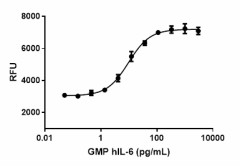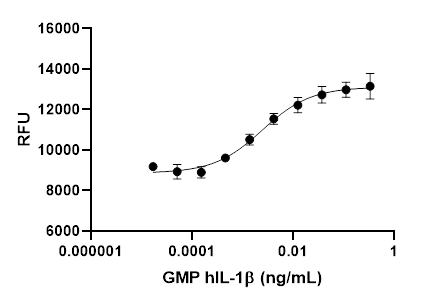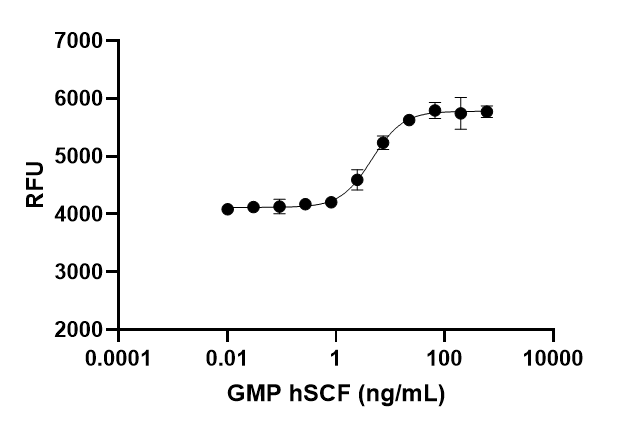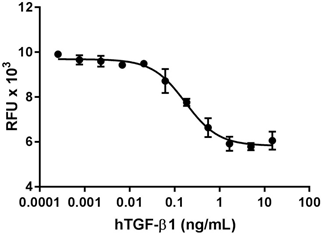- Other Names
- Interleukin-6, Interferon-β2, B cell stimulating factor-2 (BSF-2), Cytotoxic T cell differentiation factor (CDF), Hepatocyte stimulating factor (HSF), Hybridoma/plasmacytoma growth factor (HPGF)
- Ave. Rating
- Submit a Review
- Product Citations
- publications

-

GMP recombinant human IL-6 induces proliferation of a 7TD1 cells in a dose-dependent manner with an ED50 range of 4 - 20 pg/mL.
| Cat # | Size | Price | Quantity Check Availability | Save | ||
|---|---|---|---|---|---|---|
| 570814 | 25 µg | 512€ | ||||
| 570816 | 100 µg | 1308€ | ||||
IL-6 is a multifunctional cytokine that can regulate various immune and inflammatory responses. Several studies have suggested a crucial role for IL-6 in angiogenesis. The use of mice deficient in IL-6 (-/-) demonstrated a critical role for this protein in a mouse model of lung angiogenesis. IL-6 has been shown to cause proliferation and migration of systemic endothelial cells in culture (1). The classical responsiveness to IL-6 is governed by a receptor complex consisting of two membrane-bound subunits, an 80-kD cognate chain (IL-6R), and a ubiquitously expressed 130-kD β-chain receptor (gp130) which acts as the universal signal-transducing element for all IL-6 family cytokines (2). Alternatively, IL-6 regulation of leukocyte trafficking relies upon signaling via its soluble IL-6R (termed IL-6 trans-signaling) (3). IL-6 plays a major role in regulating neutrophil clearance during acute peritoneal inflammation; as a result of specific down-regulation of neutrophil-attracting chemokine (CXCL1/KC) production (4). IL-6 is a key factor that reciprocally regulates Th17 and Foxp3(+) Treg differentiation by inhibition of TGF-beta induced Foxp3 and induction of RORɣt, a Th17 lineage-specific transcription factor (5).
Product DetailsProduct Details
- Source
- Human IL-6, amino acids Pro29-Met212 (Accession # NM_000600) was expressed in E. coli.
- Molecular Mass
- The 185 amino acid N-terminal methionylated recombinant protein has a predicted molecular mass of 21 kD. The DTT-reduced and non-reduced protein migrate at approximately 23 kD by SDS-PAGE.
- Purity
- > 95%, as determined by Coomassie stained SDS-PAGE
- Formulation
- 0.1 µm filtered protein solution is in 10 mM NaH2PO4, 150 mM NaCl, pH 7.2.
- Endotoxin Level
- Less than 0.1 EU per µg protein as determined by the LAL method
- Concentration
- 500 µg/mL
- Storage & Handling
- Unopened vial can be stored between 2°C and 8°C for up to 2 weeks, at -20°C for up to six months, or at -70°C or colder until the expiration date. For maximum results, quick spin vial prior to opening. The protein can be aliquoted and stored at -20°C or colder. Stock solutions can also be prepared at 50 - 100 µg/mL in appropriate sterile buffer, carrier protein such as 0.2 - 1% endotoxin-free BSA or HSA can be added when preparing the stock solution. Aliquots can be stored between 2°C and 8°C for up to one week or stored at -20°C or colder for up to 3 months. Avoid repeated freeze/thaw cycles.
- Activity
- ED50 = 4 - 20 pg/mL, as determined by a dose-dependent stimulation in a 7TD1 cell proliferation assay. The specific activity of GMP recombinant human IL-6 is approximately 5.0 x 104 IU/µg when compared against the WHO Reference Reagent for Human IL-6 (NIBSC code: 89/548) as determined by the dose-dependent stimulation of 7TD1 cell proliferation.
- Application
-
Bioassay
Cell cultures - Application Notes
-
BioLegend carrier-free recombinant proteins provided in liquid format are shipped on blue ice. Our comparison testing data indicates that when handled and stored as recommended, the liquid format has equal or better stability and shelf-life compared to commercially available lyophilized proteins after reconstitution. Our liquid proteins are validated in-house to maintain activity after shipping on blue ice and are backed by our 100% satisfaction guarantee. If you have any concerns, contact us at tech@biolegend.com.
- Disclaimer
-
GMP Recombinant Proteins. BioLegend GMP recombinant proteins are manufactured in a dedicated GMP facility and compliant with ISO 13485:2016. For research or ex vivo cell processing use. Not for use in diagnostic or therapeutic procedures. Our processes include:
- Batch-to-batch consistency
- Material traceability
- Documented procedures
- Documented employee training
- Equipment maintenance and monitoring records
- Lot-specific certificates of analysis
- Quality audits per ISO 13485:2016
- QA review of released products
BioLegend GMP recombinant proteins are manufactured and tested in accordance with USP Chapter 1043, Ancillary Materials for Cell, Gene and Tissue-Engineered Products and Ph. Eur. Chapter 5.2.12.
Antigen Details
- Distribution
-
IL-6 is released by activated T cells, B cells, monocytes, macrophages, fibroblasts, epithelial cells, and endothelial cells.
- Function
- Upregulated by IL-1, PDGF, IFN-β, TNF-α, NGF, and IL-17 and downregulated by glucocorticoids IL-4 and TGF-β
- Interaction
- T cells, B cells, hepatocytes, and cholinergic neurons
- Ligand/Receptor
- Heterodimer IL-6Rα (CD126)/IL-6Rβ (CD130; gp130) and soluble IL-6R
- Cell Type
- Hematopoietic stem and progenitors
- Biology Area
- Cell Biology, Immunology, Innate Immunity, Stem Cells
- Molecular Family
- Cytokines/Chemokines
- Antigen References
-
- McClintock JY and Wagner EM. 2005. J. Appl. Physiol. 99:861.
- Murakami M, et al. 1993. Science 260:1808.
- Cartmell T, et al. 2000. J. Physiol. 526:653.
- Jones SA, et al. 2001. FASEB J. 15:43.
- Fielding CA, et al. 2008. J. Immunol. 181:2189.
- Sonderegger I, et al. 2008. Eur. J. Immunol. 38:1833.
- Erta M, et al. 2012. Int. J. Biol. Sci. 8:1254.
- Rosean TR, et al. 2014. Immunol. Res. 59:188.
- Gene ID
- 3569 View all products for this Gene ID
- UniProt
- View information about IL-6 on UniProt.org
 Login / Register
Login / Register 



















Follow Us